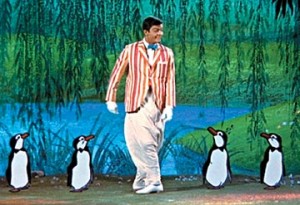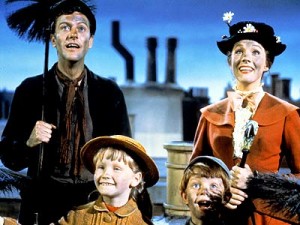Bruce Almighty
Posted on May 21, 2003 at 5:28 am
You could not ask for a better showcase for what Jim Carrey does best than this comedy about a man who is given all of God’s powers and has no compunction about using them for cheap thrills and petty payback. Director Tom Shadyac, who worked with Carrey on his biggest hits, “Ace Ventura” and “Liar, Liar,” once again gives us Carrey in a role designed to get the most out of his talent for wildly elastic physical comedy.
There’s a strong sense of art imitating life here, at least the life of Carrey the performer, if not Carrey the person. Carrey the performer has not had the success he hoped for in more serious roles, particularly in “The Majestic” and “The Man in the Moon.” So when his character is told throughout this movie that there is nothing wrong with being funny (and when God, played by Morgan Freeman, says “All-righty then!” Ace Ventura’s favorite catch phrase), and when he plays a character with God’s powers (which must feel pretty close to the omnipotent power our society gives to celebrities) and yet he ends up being satisfied with what makes people laugh, it is hard not to think that there is something more than resonance here for Carrey. It is almost as though he is saying “All-righty then! If this is what you want to see, here it is!” to the audience.
Carrey plays Bruce Nolan, a television news reporter who resents being assigned to silly stories like the world’s biggest cookie and the anniversary of the Niagara Falls boat tour. He wants to do serious stories and he thinks he should be the anchor. He lives with his girlfriend, Grace (Jennifer Aniston), whose name is an indication of the script’s idea of a theological reference.
Despite his love for Grace, Bruce is shallow and self-centered. When he loses the anchor job to a rival (Comedy Central “Daily Report’s” Steve Carell), he furiously explodes on the air and is fired. He tries to help a homeless man, and is beat up by thugs. Bruce thinks that life is very unfair, so he complains to God. God challenges him to try out His powers, as long as he does not tell anyone or interfere with free will.
Bruce spends the first week using the powers for cheap thrills. He parts the red soup instead of the Red Sea and makes the cars blocking him in a traffic jam move out of the way. And he enjoys petty payback. This part of the movie is fun — who would not like to be able to do anything without any guilt or accountability — and it is very funny, especially when Bruce makes his rival mess up on camera. The best physical comedians, like Carrey, perfectly enact the id out of control, the mean little imp that lives in each of our hot little hearts. That is ideal for embodying Bruce’s juvenile uses of his new power.
But then Bruce has to realize that power and responsibility go together and that he cannot be happy until he understands that other people’s happiness has to come first. That part of the movie does not work because it is pretty clear that Bruce never cares about anyone but himself. There is a hollow, hypocritical, and faintly creepy sense that the people behind the movie don’t really understand the message themselves.
Bruce’s carelessness in lassoing the moon (a reference to “It’s a Wonderful Life” that is hammered home later on when we get a glimpse of that scene on television), unleashing an asteroid, and making hundreds of lottery winners, is portrayed as humorous. Even though we get glimpses of the disasters he causes, Bruce never does and never has to clean up the mess.
When Bruce tells God that he wants to solve the problems of world hunger and peace, God tells him that is a “Miss America answer” and His goal seems to be to get Bruce to think about what would make him happy with no regard for anyone but himself and the woman he loves. And life and art come together as it becomes clear that Carrey the performer is no more generous than Bruce the anchorman; Bruce’s failure to appreciate the sweet and ever-forgiving Grace is less of a, well, sin, than Carrey’s failure to make use of the considerable comic talents of the woman who plays her. It’s a shame to see Aniston in essentially an arm candy role. The result is a movie that, despite some very funny moments, makes the same mistake as its main character without learning any lessons about maturity or responsibility. It teeters between deranged comedy and sentimental fable, and is unsatisfying in both categories. What Bruce should have used his powers for was a better script.
Parents should know that the movie has very mature material for a PG-13, including very strong language and crude humor after a thug makes a rhetorical reference to a monkey coming out of his butt. Bruce gives “pleasure” to Grace as they prepare for a sexual encounter. There is an extended joke about a dog who is not house-trained. Characters drink alcohol and Bruce uses his powers to plant bags of marijuana on rival broadcasters.
Families who see this movie should talk about what they would do if they had God’s powers. How would they decide the best way to respond to prayers? Most of the prayers in this movie are “petitionary,” meaning that they are asking for something, usually love, money, or status-related. What other kinds of prayers are there? Some families will want to discuss their own ideas about God and prayer.
Families who enjoy this movie will also enjoy “Oh God,” with George Burns and John Denver. They might like to see a different portrayal of God that also discusses the importance of free will in the wonderfully imaginative “Time Bandits.” And every family should watch and discuss “It’s a Wonderful Life” with Jimmy Stewart and Donna Reed.


